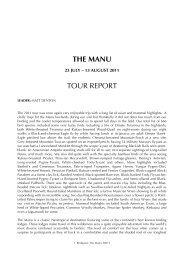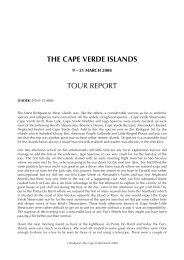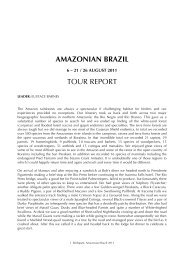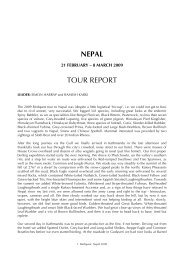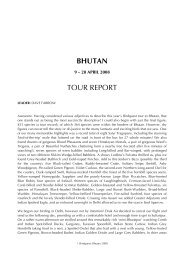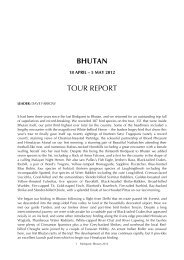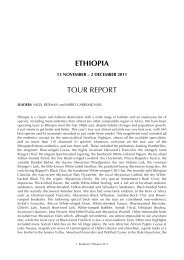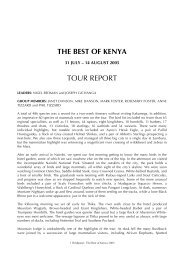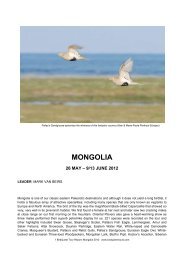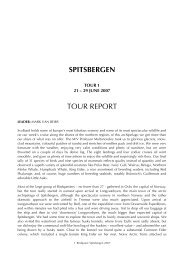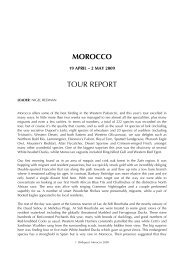INDONESIA (LESSER SUNDAS) REP 10 - Birdquest
INDONESIA (LESSER SUNDAS) REP 10 - Birdquest
INDONESIA (LESSER SUNDAS) REP 10 - Birdquest
Create successful ePaper yourself
Turn your PDF publications into a flip-book with our unique Google optimized e-Paper software.
Bipolo we positioned ourselves for a boobook once more and, as night fell, we had excellent scope<br />
views of Streaked Boobook in the spotlight. It had been a superb day, with a massive <strong>10</strong>5 species<br />
recorded.<br />
Nearby Camplong was our destination the following day. We found all of our target birds during the<br />
morning. A lovely pair of Black-banded Flycatchers were highly responsive as soon as we reached the<br />
first patch of habitat, giving several nice perched views. Timor Stubtail and Buff-banded Thicketwarbler<br />
required multiple attempts, but we ended up seeing both very well on several occasions. The<br />
most difficult species was the never-stands-still Spot-breasted Dark-eye, which was seen well by less<br />
than half of us. Several Rose-crowned Fruit-doves, Plain Fairy Warbler (or Gerygone), and Sunda<br />
Bush-warbler provided added interest, while Timor Leaf-warbler was heard but not seen. We decided<br />
to go back to Bariti for the afternoon session but an hour long heavy downpour seriously spoilt things.<br />
Really strange events on Timor, where the leader had never seen a drop of rain previously! We did<br />
‘up’ our totals of Pink-headed Imperial Pigeon and Olive-shouldered Parrot however, to two and five<br />
respectively.<br />
Leaving Kupang behind, we headed inland and uphill to Soe. On the way we spent nearly three hours<br />
at Camplong, in search of the elusive Spot-breasted Dark-eye. We finally tracked down three birds<br />
that showed well for all of us. After check-in and lunch at Soe, and a welcome nap, we made our first<br />
visit to Oelnasi, an area of monsoon forest 15km back towards Kupang. Unfortunately we were to<br />
register a blank with our two target pigeons, Barred-necked Cuckoo-dove and Timor Black Pigeon.<br />
Perhaps it was something to do with the strong winds. We would have to wait for another attempt<br />
later on. Two more Spot-breasted Dark-eyes were seen briefly on the way out to the site, and after<br />
dusk we tried to see and tape-record the intriguing local form of Large-tailed Nightjar, which certainly<br />
sounds like a distinct species. With wind and light rain, our options were severely compromised, but<br />
Sieghard managed to see one feeding.<br />
A very early start the following morning, took us along an unbelievably bad road to a point as close<br />
as we could safely get, to the start of the trail to Gunung Mutis, Timor’s highest mountain. Sadly, the<br />
road had seriously deteriorated since the previous year. Coupled with this, we had further than usual<br />
to walk, and were welcomed by fog and light rain. Still, we persevered. Timor Leaf-warbler and flying<br />
Olive-headed Lorikeets were noted, we scoped the gorgeous Metallic Pigeon, and we had great looks<br />
at ‘Timor’ Pygmy Wren-babbler, a likely future split. Picking up the Mutis trail, we found larger than<br />
normal numbers of Island Thrushes. A few Snowy-browed Flycatchers drew our attention, the leafwarbler<br />
showed really well, and we plodded on to the big clearing en route to Gunung Mutis. The<br />
cloud base was low, and the wind strong, so we decided against the summit cone, and headed down<br />
into some nice forest below us. Suddenly we heard the distinctive low rumbling call of Timor<br />
Imperial Pigeon, and made a beeline towards it. On the way three noisy lorikeets flew into some trees<br />
above us. A quick look through the scope showed them to be the neat and very hard to see Iris<br />
Lorikeet, and we managed some decent perched views while they stuck around. We carried on<br />
towards the imperial pigeon that was still calling, noting many Metallic Pigeons and some Blackbacked<br />
Fruit-doves on the way. Suddenly a Timor Black Pigeon called nearby – unbelievable at this<br />
site. A quick play of the call and a pair came in several times to investigate, giving some really nice<br />
looks. We hadn’t even thought of seeing this one here! The imperial pigeon continued to prove<br />
elusive, but after lunch we finally found one perched briefly near a fruiting tree. Only a few of us had<br />
managed to see it perched however, so we stuck around as long as we could. Right at the last minute<br />
Jürgen and Craig noticed a pigeon fly in front of us as we were ready to go, and Jürgen called-it in an<br />
exposed tree top. We proceeded to get detailed scope views for over 20 minutes – amazing for this<br />
shy and rare bird. A brisk hike back to the bus was punctuated by many Olive-headed Lorikeets flying<br />
over and some briefly perched, and two pairs of the distinctive local form of Little Cuckoo-dove.<br />
Our last day on Timor began with a predawn raid on the local form of ‘Large-tailed Nightjar’ at<br />
Oelnasi. Unfortunately, after tracking a close calling bird down, it promptly shut up! A short distance<br />
4 <strong>Birdquest</strong>: The Lesser Sundas 20<strong>10</strong>




